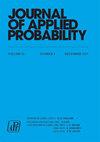负弯曲流形上马尔可夫链的反常递推
IF 0.7
4区 数学
Q3 STATISTICS & PROBABILITY
引用次数: 0
摘要
摘要给出了负曲率流形上离散马尔可夫链的递归-暂态分类。我们的分类只依赖于与链的增量相关的几何量,通过黎曼指数映射定义。我们推断出在每一点上平均漂移为零的循环链不可能是一致椭圆的,这与欧几里得情况不同。我们也给出了负弯曲流形上零漂移循环链的自然例子,包括随机不完全流形。本文章由计算机程序翻译,如有差异,请以英文原文为准。
Anomalous recurrence of Markov chains on negatively curved manifolds
Abstract We present a recurrence–transience classification for discrete-time Markov chains on manifolds with negative curvature. Our classification depends only on geometric quantities associated to the increments of the chain, defined via the Riemannian exponential map. We deduce that a recurrent chain that has zero average drift at every point cannot be uniformly elliptic, unlike in the Euclidean case. We also give natural examples of zero-drift recurrent chains on negatively curved manifolds, including on a stochastically incomplete manifold.
求助全文
通过发布文献求助,成功后即可免费获取论文全文。
去求助
来源期刊

Journal of Applied Probability
数学-统计学与概率论
CiteScore
1.50
自引率
10.00%
发文量
92
审稿时长
6-12 weeks
期刊介绍:
Journal of Applied Probability is the oldest journal devoted to the publication of research in the field of applied probability. It is an international journal published by the Applied Probability Trust, and it serves as a companion publication to the Advances in Applied Probability. Its wide audience includes leading researchers across the entire spectrum of applied probability, including biosciences applications, operations research, telecommunications, computer science, engineering, epidemiology, financial mathematics, the physical and social sciences, and any field where stochastic modeling is used.
A submission to Applied Probability represents a submission that may, at the Editor-in-Chief’s discretion, appear in either the Journal of Applied Probability or the Advances in Applied Probability. Typically, shorter papers appear in the Journal, with longer contributions appearing in the Advances.
 求助内容:
求助内容: 应助结果提醒方式:
应助结果提醒方式:


